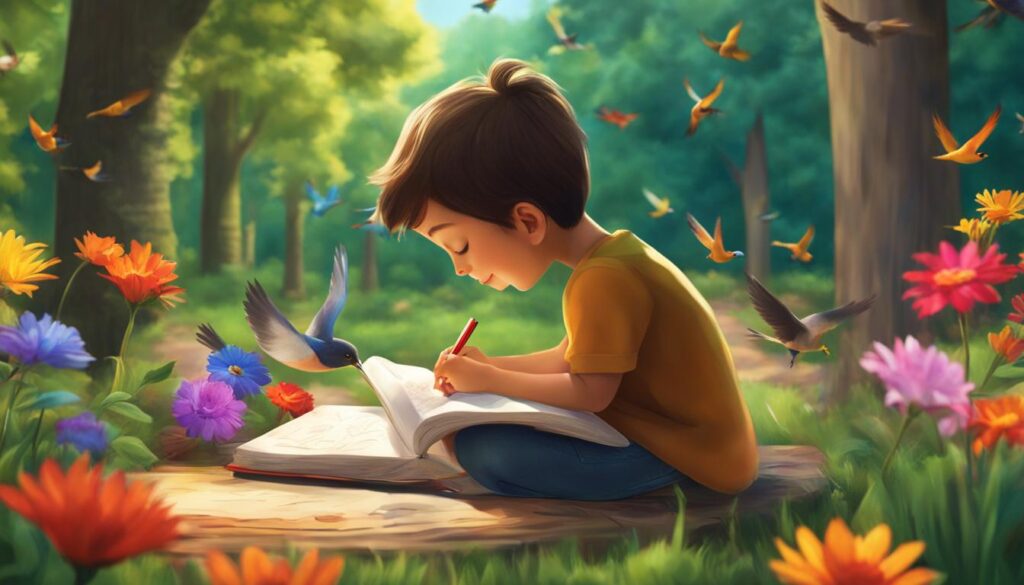We may earn money or products from the companies mentioned in this post.
Teaching gratitude to children is one of the most valuable lessons parents can impart. Gratitude is an essential element in cultivating a positive mindset and promoting overall well-being. A gratitude journal for children is a wonderful tool to empower your kids to appreciate and express gratefulness.
With a gratitude journal for children, kids can learn to focus on the positive aspects of their lives and practice gratitude regularly. By encouraging your child to write down things they are thankful for, they can develop a more optimistic outlook and build resilience against negative emotions.
Aside from its psychological benefits, a gratitude journal for children can also be a meaningful keepsake for families. As parents and children look back on the pages filled with memories of gratitude, it can be a source of joy and inspiration for years to come.
Key Takeaways:
- Teaching gratitude to children is crucial for their well-being.
- A gratitude journal for children can empower kids to cultivate gratitude and a positive mindset.
- A gratitude journal can also serve as a precious keepsake of memories and happy moments.
- Regular practice of gratitude can build resilience and emotional strength in children.
- Encouraging children to focus on the positive aspects of their life can lead to a more optimistic outlook.
The Importance of Gratitude Practice for Kids
Teaching gratitude to children is a valuable lesson that can shape their mindset and improve their overall well-being. Gratitude practice for kids involves mindfulness activities that help children cultivate a positive attitude towards life. These activities can be as simple as saying “thank you” or taking a moment to appreciate the little things in life.
Mindfulness for kids has been shown to reduce stress and promote emotional regulation. By focusing on the present moment and acknowledging their thoughts and feelings, children can develop resilience and cope with difficult situations better.
Gratitude Practice Ideas for Kids
Here are some gratitude practice ideas for kids:
- Gratitude journaling: Encourage your child to write down what they are grateful for each day. This can be as simple as a few words or a sentence.
- Gratitude jar: Decorate a jar and fill it with notes of gratitude. Each day, have your child write down something they are thankful for and add it to the jar. On special occasions, you can read the notes together.
- Gratitude walk: Take a walk with your child and encourage them to notice the beauty around them. Ask them to point out things they are grateful for, like a flower or a butterfly.
The Benefits of Gratitude Practice for Kids
| Benefit | Description |
|---|---|
| Improved mood | Gratitude practice can increase positivity and reduce negative emotions. |
| Better relationships | Expressing gratitude can strengthen relationships with family and friends. |
| Increased resilience | Mindfulness activities can help children cope with stress and develop resilience. |
By incorporating gratitude practice and mindfulness activities into your child’s routine, you can help them develop a positive attitude towards life and foster a sense of well-being.
Enhancing Mindfulness with a Children’s Gratitude Journal
A children’s gratitude journal can be a valuable tool in cultivating mindfulness and nurturing a positive attitude. By encouraging your child to reflect on the good things in their life, they can develop a sense of gratitude and appreciation for the world around them.
Here are some gratitude journaling prompts for kids that can help enhance mindfulness and encourage a grateful attitude:
- What are three things that you are grateful for today?
- How have you shown kindness to others today?
- How has someone else shown kindness to you today?
- What is one thing that made you happy today?
- What is one thing you learned today that you are thankful for?
These prompts can be used as a starting point for your child’s gratitude journaling practice. Encourage them to write down their thoughts and feelings in a notebook or journal, and to revisit their entries periodically to reflect on their progress and growth.
In addition to gratitude journaling, there are other mindfulness activities that can complement a children’s gratitude journal, such as:
- Meditation
- Breathing exercises
- Mindful coloring
- Yoga
These activities can help your child develop focus, calmness, and emotional regulation, which can then contribute to a more positive and grateful mindset.
“Gratitude turns what we have into enough.” – Anonymous
In short, a children’s gratitude journal can be a wonderful way to enhance mindfulness and encourage thankfulness in your child. By incorporating journaling prompts and mindfulness activities into their routine, you can help your child develop a lifelong habit of appreciation and positivity.
Nurturing Thankfulness through Gratitude Activities for Children
Gratitude activities for children are a fun and engaging way to nurture a sense of thankfulness and appreciation in your child. Whether it’s through gratitude crafts, games, or other activities, there are many ways to incorporate gratitude into your child’s daily routine.
Gratitude Journaling
One of the most popular gratitude activities for children is journaling. A children’s gratitude journal can encourage your child to reflect on the positive things in their life and develop a habit of gratitude. Consider using prompts such as “What are you thankful for today?” or “Name one person who made you happy today and why.” This can be a daily or weekly activity, depending on your child’s preferences.
Gratitude Tree
A gratitude tree is a craft activity that involves creating a tree out of construction paper or other materials and adding leaves with things your child is grateful for. This can be a wonderful visual reminder of all the things they have to be thankful for, and it makes for a great decoration in their room.
Gratitude Jar
A gratitude jar is another fun and simple activity that can be done with your child. Simply find a jar and encourage your child to write down things they are thankful for and place them in the jar. You can then read through the notes together whenever you need a little boost of positivity.
Gratitude Scavenger Hunt
A gratitude scavenger hunt is a fun way to get your child thinking about all the things they have to be thankful for. Create a list of items for them to find that relate to gratitude, such as a beautiful flower, a kind person, or a favorite toy. This can be a great way to spend time outside and encourage mindfulness.
Gratitude Board Game
If your child enjoys playing board games, consider creating a gratitude-themed game together. You can make a DIY board with spaces for different gratitude-related prompts and have your child answer them as they move through the game. This can be a fun and interactive way to get your child thinking about all the things they have to be thankful for.
Conclusion
As parents, we all want to raise our children with a positive mindset. A gratitude journal for children can be a helpful tool in achieving that goal. By encouraging gratitude practice and activities, we can instill a sense of appreciation and mindfulness in our children.
Children who practice gratitude have been shown to have better emotional regulation, improved self-esteem, and stronger relationships with others. By incorporating a children’s gratitude journal into their routine, we can help our kids develop a lifelong habit of positivity.
Begin the Journey
Start by introducing your child to the concept of gratitude. Teach them to appreciate the small things in life and find joy in the present moment. Then, encourage them to write down what they are grateful for in a gratitude journal for children.
Make It Fun
Gratitude activities for children can be a fun and engaging way to nurture thankfulness. Encourage your child to create a gratitude jar, where they can place notes about the things they are thankful for. Or, try a gratitude scavenger hunt, where they search for items in nature that they are grateful for.
Unlock Inner Positivity
A positive mindset for children is essential for their overall well-being. By encouraging gratitude practice and activities, we can help our children unlock their inner positivity and live a fulfilling life. So, empower your kids with a gratitude journal for children today, and watch as they thrive!
FAQ
What is a gratitude journal for children?
A gratitude journal for children is a notebook or journal specifically designed to help kids cultivate a sense of gratitude. It prompts them to write down things they are grateful for, encouraging a positive mindset and appreciation for the good things in life.
Why is teaching gratitude important for children?
Teaching gratitude to children is important because it helps them develop a positive outlook and a sense of appreciation. It promotes emotional well-being, empathy, and resilience, while also fostering stronger relationships and a greater sense of happiness.
How can mindfulness activities benefit kids?
Mindfulness activities can benefit kids by helping them stay focused, manage stress, and regulate their emotions. These activities promote self-awareness, empathy, and a sense of calm, which are essential for overall well-being and mental health.
What can a children’s gratitude journal offer?
A children’s gratitude journal offers a structured and fun way for kids to cultivate gratitude. It provides prompts and activities that encourage them to reflect on positive experiences, express gratitude for things big and small, and develop a mindset of appreciation.
How can gratitude activities enhance thankfulness in children?
Gratitude activities can enhance thankfulness in children by making the practice of gratitude more interactive and enjoyable. These activities help children engage their senses, express gratitude creatively, and strengthen their ability to recognize and appreciate the good things in their lives.
How can a gratitude journal shape a positive mindset in children?
A gratitude journal can shape a positive mindset in children by encouraging them to focus on the positives in their lives. By regularly writing down things they are grateful for, children develop a habit of looking for and appreciating the good, which can lead to a more optimistic and resilient outlook.
How can I introduce a gratitude journal to my child?
Introducing a gratitude journal to your child can be as simple as explaining the concept of gratitude and its benefits. Encourage them to write down a few things they are grateful for each day and provide them with a dedicated journal to make it a regular practice. Make it fun by using colorful pens or stickers to personalize their journal.
Affiliate Disclosure: This post may contain affiliate links. If you purchase through our link, we may receive a small commission, but at no additional cost to you. For more information, please see our Disclosure statement.



